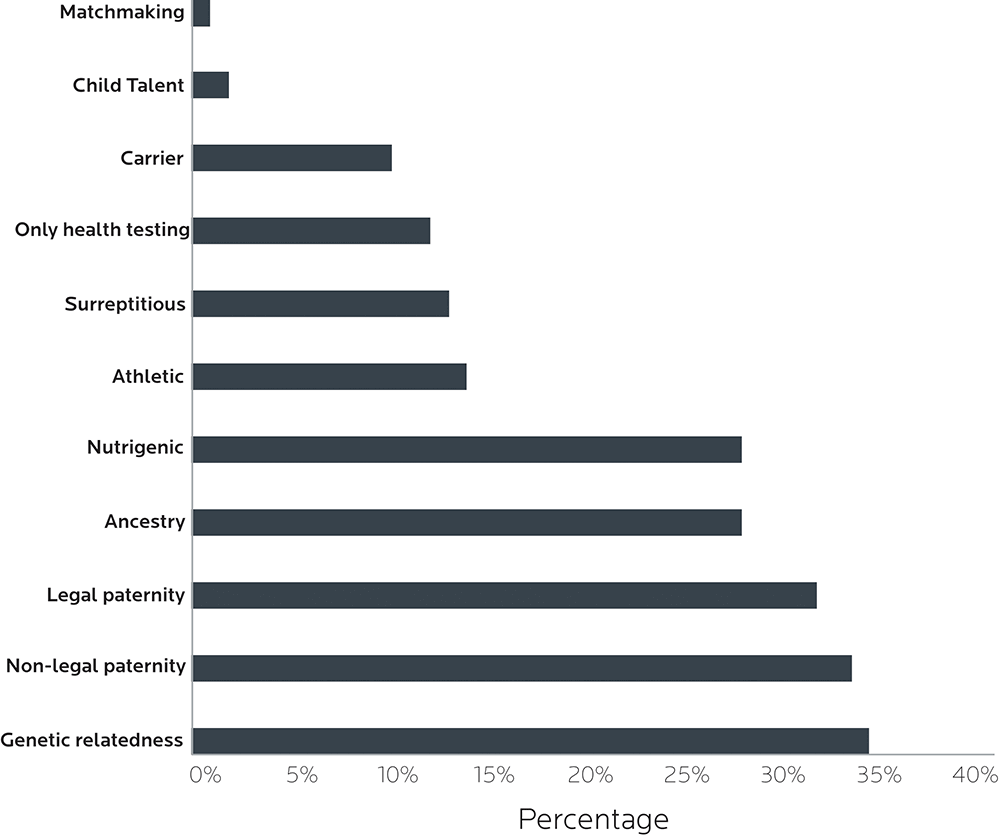Chapter 4
Specific genetic testing services
What you’ll learn in this chapter
In this chapter, we’ll cover:
- What types of tests are available commercially?
- How scientifically credible are they?
- How well-replicated are they? (In other words, are they the same from lab to lab?)
- Why did we choose particular tests?
- What does this mean for you as a consumer?
But first:
Here are some things to keep in mind.
Some quick refreshers and reminders:
- One gene can affect many outcomes and processes.
It’s not usually a simple one-to-one ratio where Gene X completely controls Process Y.
- Many links between specific genes or SNPs are only associations, not causes.
We can’t say right now that having a certain genetic variation necessarily makes something happen.
We can only say that in this particular population studied, we can see that there is maybe something happening with a particular gene or SNP. That’s all.
- Genes are not destiny.
Outside of some highly genetically determined diseases (such as Huntington’s disease, cystic fibrosis or Down syndrome), we can, to some degree, affect the outcome of our biological programming.
Even if one particular gene determines 70% of an outcome (which is a lot, relatively speaking), we may be able to affect the other 30%. Many genes and SNPs we’ll look at have much less of a role.
- We’re usually talking about possibilities and probabilities.
You’ll see words like maybe, could be, sometimes, risk, percentages, odds, likely.
Rarely can we know for sure that something will happen… or even what that something is. This might be disconcerting and hard to understand, so celebrate this feeling of ambiguity. It runs throughout biology.
- The research is new, often un-reproduced, and unreplicated.
We can’t say for sure based on a single study of fifty people of Finnish, Fijian, or Filipino descent whether that study has any relevance to you — even if you’re Finnish, Fijian, or Filipino too.
4 questions to ask about genetic testing
We also suggest you review our 4 simple questions to ask about genetic testing:
Is a particular test:
- Descriptive: Does it tell me something about the person being tested?
- Diagnostic: Does it allow me (or a medical professional) to diagnose a problem or characteristic?
- Predictive: Does it allow me to predict some future challenge or occurrence, such as a disease or health risk later in life?
- Prescriptive: Does it tell me what to do next, or in the future?
Keep these points and questions in mind as you read through this chapter, and the rest of the book.
Genetic testing services: What’s available?
There are many genetic testing services available, which have different purposes, such as:
- specific disease risks (such as cancer);
- carrier status (in other words, whether you’re carrying something that you may not want to pass on to your offspring);
- ancestry and migration patterns;
- paternity and relatives (e.g., whether two people are related, or screening for donor tissue matches);
- specific traits;
- newborn health;
- drug response; or
- individualized health, nutrition, and fitness recommendations.
A study of 246 direct-to-consumer genetic testing services found that while nutrigenetic tests were popular, the pressing question of “What should I eat?” was outweighed by “Is my kid mine?” Some genetic testing services even offered a discreet “surreptitious” option, as in, “Steal a few bits of someone’s body and send it to us; we’ll tell you whether you’re about to have an awkward family conversation.”

A health, nutrition, and fitness focus
Of course, we’re interested in general health, nutrition, and fitness or athletic performance, so that’s where we focused our attention.
We looked for services that tested genetic markers known to be related to particular traits, such as:
Metabolism
- Blood sugar and insulin
- Blood lipids and lipoproteins (HDL, LDL, etc.)
- Resting metabolism
- Other factors (such as thyroid health) that can affect metabolism
- Body weight, size, and fatness (or leanness)
Food and nutrition
- Taste preferences and sensitivity
- Food intolerances
- Nutrient processing (e.g., vitamins, salt, caffeine)
Exercise and athletics
- Sprint-type vs endurance-type muscle fibers
- Muscle performance
- Response to exercise
- Recovery from exercise
We’ll cover these in more detail in upcoming chapters.
What else were we looking for?
Along with a focus on general health, nutrition, and fitness, we looked for services that fulfilled a few other criteria:
Scientific credibility
What claims were the companies making?
Research on direct-to-consumer tests has shown that many companies are making claims about their data that are not supported by scientific evidence.
For instance, they may claim to be able:
- to exactly predict your athletic talent (or your child’s);
- to tell you exactly what you should eat;
- to tell you exactly how you should exercise; or
- to tell you exactly what choices you are likely to make (for instance, whether you’re likely to give in to sugar cravings).
Unfortunately, none of these claims are true. (Yet.)
A 2015 article in the British Medical Journal examined 39 direct-to-consumer testing services, and found that:
- Over half (21 of the 39) companies didn’t actually identify the specific DNA sequence variants they tested.
- Of the 18 companies that did identify what genetic markers they used:
- 16 of 18 tested the ACTN3 R577X polymorphism (which we’ll look at in Chapter 10).
- 11 of 18 tested for the angiotensin I converting enzyme 1 (ACE) I/D polymorphism.
- Though ACTN3 and ACE polymorphisms are promising areas of research, they haven’t yet been conclusively shown to make a major difference in strength, muscularity, or athletic performance — certainly not compared to environmental influences like training.
- The number of variants tested overall was small. Most companies tested around 6. Some tested only 1, others up to 27.
When we consider that we have 3 billion base pairs of DNA, you can imagine that this is still a pretty small sample for drawing potentially big conclusions.
Another large-scale meta-analysis study reviewed research from nearly 1,200 studies on 38 genes tested by nutrigenomics companies.
They concluded that:
- Most studies couldn’t predict any useful relationship between particular genes of interest.
- When there seemed to be a link, the studies or sample sizes were too small to make broad recommendations.
Finally, what about the data used by genetic testing itself?
What if, for instance, a particular study finds an association between SNP X and Nutrient Intake Y… but the study is based on something like people’s recall of what they ate — a method known to be often so inaccurate that it’s potentially useless? If a genetic testing service bases their interpretation on this study, there’s a chance that they might not be making valid scientific claims.
This doesn’t mean, obviously, that nutrigenomics or other related types of genetic testing services are useless.
Even the skeptical meta-analysis authors called genetic testing a “highly promising tool for precision medicine”.
We just need to understand what claims are substantiated, and which ones aren’t. (Yet.)
So we looked for genetic testing services whose claims:
- were supported by the most current scientific evidence;
- were reasonable, relatively conservative, and realistic; and
- included a discussion of both limitations and advantages of their testing methods and findings.
Quality control
What processes did each lab follow?
To ensure that high-quality, standardized scientific practices are followed, most countries somehow regulate laboratory testing.
This includes ensuring:
- technical personnel are competent and qualified;
- experimental processes are recognized as legitimate and correct;
- equipment is calibrated and accurate; and
- laboratories are impartial and independent.
For instance:
- In the United States, all labs that test human specimens for health assessment or to diagnose, prevent, or treat disease must abide by federal Clinical Laboratory Improvement Amendments (CLIA) regulations.
- In Canada, the Standards Council of Canada gives accreditation to labs that meet International Standards Organization (ISO) requirements for medical labs and analysis.
- The International Laboratory Accreditation Cooperation is an umbrella organization that covers other international lab certifying bodies such as EA in the European Union, APLAC in Asia-Pacific countries, IAAC in the Americas, AFRAC in Africa, SADCA in Southern Africa, and ARAC in the Arab region.
So we looked for genetic testing services:
- who had a legitimate scientific staff;
- that use certified/accredited labs, or operate certified labs themselves; and
- who were involved in or had produced peer-reviewed research.
Reliability
If we sent the same sample to two different labs, would they come up with similar results?
Professional laboratories produce extremely reliable results — over 99.9% accuracy. They are also heavily scrutinized and monitored by industry and scientific agencies, whereas commercial labs are not.
We wanted to do our own review of the commercial services we used. So we checked:
- Would the same samples sent to different commercial labs come back with similar results?
- If we sent two of the same sample to the same lab, would we get the same results?
The answers: Yes, and yes. The results we got were a match with over 99.9% accuracy.
Our experience closely matches other studies that compared the largest direct-to-consumer testing services (such as 23andMe, deCODE, and the now-defunct Navigenics) to one another, and found that lab-to-lab correlation (in other words, how closely each lab’s results matched the others’) was 99.6 to 99.7%, though accuracy did vary somewhat for specific SNPs or disease risks.
In particular, predictions were less reliable when labs used genetic markers with only weak associations (such as, “Well, in some people, some of the time, given some environmental conditions, this SNP may be linked to a 0.1% higher chance of X”).
Predictions were more reliable with strong associations, like “Yep, you have OCTFN1, the gene that always gives people ‘octopus fingers’ 100% of the time.”
Fun factoid!
“Octopus finger” is not a thing. Do not be alarmed.
Also, do not hate on octopodes, who are simply “differently digitized”.
So we looked for genetic testing services:
- whose results were reliable and repeatable; and
- who distinguished between stronger and weaker genetic markers and associations.
Vested interests
Are the testing services selling something else?
In many cases, genetic testing services may offer extended services (such as an app, “individualized” meal planning or tracking of other indicators like physiological performance) that actually have nothing to do with genetic data.
These other services may indeed be helpful, but that help didn’t actually come from knowing your genetic information.
For instance, while tracking your sleep habits or food intake is very useful and can help you make some important decisions, that useful data is not based on your “sleep DNA” or “menu DNA”. It’s just plain old daily-life observation that anyone can do. (Back in the old days, we just called that kind of careful observation and outcome-based decision making “coaching”. Harrumph.)
Other services may sell supplements once they have determined your “genetic requirement” for extra vitamins, minerals, antioxidants, etc. At the time of writing, there are very, very few known, evidence-based, genetic requirements for specific supplements. (You may benefit from supplements for other reasons, but likely not because of any particular SNP that you have.)
So we looked for genetic testing services that:
- were primarily testing, analysis, and/or interpretation services; and
- did not sell additional products, unless those products and services were clearly relevant to the genetic data (such as genetic counseling).
Testing methods and technologies
How were the samples tested and analyzed?
There are several technologies and methods that can be used for genetic testing.
- SNP genotyping arrays are fast and cheap. They look at a series of predetermined locations on the genome (usually hundreds of thousands to millions) to look for SNP variations. SNP genotyping works well if you know which SNPs you are looking for, or want to search for novel associations among well-known regions. It’s less useful when the variations are not SNPs, or when you are looking for variations that aren’t well characterized or understood.
- Sequencing is building a list of actual nucleotides, in order. While a SNP array might be able to tell you if you have a nucleotide at a certain position, sequencing can tell you the actual genetic code around that position. SNPs can tell you whether it’s A or T; sequencing can tell you that it’s AACCTAATTAGA or TACCTAATTAGA, or even that it’s AACCTACTACTAATTAGA. An intrepid researcher can still do sequencing by hand, but it is a tedious and laborious process, sweated over by graduate students and postdocs toiling in the basement. These days, most sequencing is done by high-throughput machines that perform the chemical processes of sequencing, automated signal processing to transform chemical information to digital and computers to turn the vast amounts of raw data into usable information.
- Exome sequencing provides the genetic code for the exome (every part of the genome that codes for a part of a protein), which is about 1% of the total human genome. If researchers are specifically interested in the protein-coding regions of the genome, exome sequencing gives the most accurate and cost-effective data. It doesn’t include the DNA regions outside of exomes, which have important regulatory features.
- Whole-genome sequencing can give researchers a view of the entire genome. The entire genome is sequenced, regardless of whether a given DNA region codes for a gene, provides a regulatory function, or just happens to be a retroviral genome that lodged itself in one of our ancestors and got cozy.
If researchers need a detailed, accurate view of a specific set of targeted stretches of DNA, they might use amplicon sequencing.
In this technique, technicians use the polymerase chain reaction (PCR) to make billions and billions of copies of a previously-identified stretch of DNA, and sequence these copies (known as amplicons). Sequencing PCR products gives a very high-fidelity view of the genetic code, but is of very limited use if researchers don’t know what they are looking for.
There are other preparation techniques that allow researchers to target specific functions or regions of DNA.
For example, chromatin immunoprecipitation (ChIP) targets DNA-binding proteins so you are only sequencing regions of DNA that are bound to chromatin.
All sequencing technologies will have some bias and error. Biology and chemistry are inherently chaotic processes, so nothing is perfect.
But of course, we want to get as close as possible to that magical 100% accuracy.
So we looked for genetic testing services that:
- explained their process and method, including what they tested and how; and
- used testing methods (such as the Illumina chip) that are widely accepted as industry standards.
Analysis and interpretation
How valid is the analysis, and how useful is the interpretation of the results?
An analysis that says, “Here is a specific SNP that you have, here’s what we know about it, and here’s what it might say about you if you’re from X Population, but we’re not totally sure just yet so check back in 10 years” is probably accurate.
An analysis that says, “BEHOLD YOUR GENES!! BROCCOLI IS DEAD TO YOU NOW!!”… Hmm, maybe not so valid.
So we looked for genetic testing services that:
- offered cautious, careful, conservative analyses and presentation of findings; and
- supported those findings with specific citations of peer-reviewed studies.
Risks and probabilities in context
How well does the test explain absolute and relative risk?
As we learned in the last chapter, biology is probability.
Probability is almost never perfection. Risks are possibilities, not destinies.
Thus, we want genetic testing services that give us our test results in context.
If we have, for example, a 1.5 higher lifetime risk of Disease X, what does that really mean?
We have to know:
- what “lifetime risk” means: Will we likely get this disease at age 20? 50? 99?
- how prevalent this disease is in our population: Is it a serious health threat, or a rare condition?
- what other factors besides this genetic variant are involved: Can we escape Disease X by doing Behavior Y? For instance, if we have a higher genetic risk of lung cancer, can we avoid that cancer by not smoking?
Let’s say there’s a disease known as Crepitus Umbilicus.
It’s terrible, really; people’s bellybuttons spontaneously explode and shoot through their spine. It’s an awful way to go out — it happened to your dad while he was peacefully watching a hockey game on TV one day.
So you’re worried: Will your bellybutton explode too?
You get genetic testing to see if you carry the deadly CRUMB gene variant.
Now let’s say that Crepitus Umbilicus affects, for example, 50% of the population. That’s the absolute risk — in other words, everyone’s risk all lumped together. That means 1 in 2 people will likely, at some point, die by exploding bellybutton.
Let’s say you have a 1.5 higher chance of getting that disease. That’s your relative risk — in other words, how your particular probability stacks up against everyone else.
You might also want to know your odds ratio, which is the relationship between an exposure and an outcome. An odds ratio (OR) tells you how likely it is that Outcome X will happen if you’re exposed to Condition Y — for instance, how likely it is that you’ll get this disease given your genetic makeup.
With an absolute risk of 50%, a 1.5 higher chance of getting it is a strong possibility for you, and you should probably consider taking steps to change your odds, such as surgically removing your bellybutton before it blows up. (Don’t worry, there are many very realistic bellybutton prostheses these days.)
But if Crepitus Umbilicus affects only 0.00000005% of the population (in other words, 1 in 2,000,000 people rather than 1 in 2), a 1.5 higher chance of getting it… eh, probably don’t worry too much. Just pack a little flame retardant foam in your navel before you go to sleep each night, and you’ll likely be just fine.
So we looked for genetic testing services that:
- gave us probabilities based on known epidemiological data;
- were clear about the limitations of these data and risk predictions; and
- put results in context as much as possible by telling us the absolute risk as well as the relative risk.
Support for next steps
Does this genetic testing service help me understand what to do next?
If so, how? And how appropriate are the recommendations?
Again, research suggests that simply knowing about your DNA — while very cool — may not change your behavior. In some cases, people may feel as though they have less control over their choices once they know their genetic test results.
It might not be within the testing service’s scope of practice to make specific recommendations about what to do next, but were they able to help us identify where else we might look for guidance?
So we looked for genetic testing services that:
- offered relatively impartial interpretations and support that might help people take realistic, productive next steps.
Choosing testing services
For general health, nutrition, and fitness information, there are many services available.
For instance:
- 23andMe was one of the first on the commercial testing scene, and offers a wide array of genetic data ranging from ancestry, to health risks, to traits. You can spend days deep-diving into all the scientific research and analysis that they’ve collected. https://www.23andme.com/
- DNAFit tests about two dozen genes that are related to metabolic health, nutrition, and athletic performance, and then offers comprehensive recommendations for what to do with the test results. https://www.dnafit.com/
- Orig3n has a variety of kits available that test sets of variants for fitness and performance. https://orig3n.com/
- Habit offers genetic testing, personalized nutrition prescriptions, and even meal delivery based on your “individualized nutrition plan”. https://habit.com/
- LifeGenetics is heavily focused on weight loss, offering menu planning based on test results. http://lifegenetics.net/
- Nutrigenomix, based out of the University of Toronto, uses a panel of 45 genetic markers to explore factors related to weight management and body composition, nutrient metabolism, eating habits, cardiometabolic health, food intolerances, and physical activity. https://www.nutrigenomix.com/
Other services will analyze existing data (for instance, from 23andMe) in ways that the original labs might not. For instance:
- Genetic Genie explores genetic markers linked to detoxification and methylation. It’s also free. http://geneticgenie.org/
- Athletigen doesn’t do their own testing (they send it to a lab), but they offer analysis and interpretation of particular genetic indicators of athletic performance. https://athletigen.com/
What we chose and why
We’d love to say that we’re actually shills for Big Genome and that they gave us a bunch of cool swag like personal polymerase shaker cups, Happy the Haplotype stuffed toys, or a protruding-eyebrow-ridge piercing for our co-author Krista, who scores big with the highest percentage of Neanderthal DNA.
But no.
In most cases, we don’t know the testing services, and they don’t know us.
(Well, they know us, kinda… since DNA is us. But they don’t usually know us, like “Hey what’s up how are the kids and your sports team?” know us.)
We chose three services to explore in particular for this book: 23AndMe, GeneByGene, and Nutrigenomix.
Here’s why.
- They’re relatively cheap. Hey, we ain’t made of money. At time of writing, for instance, 23andMe cost $200 US.
- They’re easily available. Spit in a tube, mail it off. A few weeks later, you get your data. (Co-authors Helen and Alaina also took and prepped blood samples for GeneByGene, who offered us the ability to test with both blood samples and DNA we prepped ourselves in PN’s lab.)
- They’re relatively accessible. Anyone who can afford it can do it. You don’t need to be a healthcare professional or a researcher to get access to your genetic data. The basic Nutrigenomix kits are used in undergraduate courses.
- They can connect to other services and analysis. Once you have your 23andMe data file, for instance, you can link it to other services (such as Athletigen or Genetic Genie) who will run different analyses on it.
- They’re relatively accurate. For instance, 23andMe uses the Illumina HumanOmniExpress-24 format chip (considered an industry standard) in a CLIA-certified, CAP-accredited laboratory in the United States. Nutrigenomix uses a similar process in a top university laboratory in Canada, and clinically-focused GeneByGene has an excellent facility in Texas.
- 23andMe and Nutrigenomix analyze and interpret the data for you. (GeneByGene provided us only raw data that we had to analyze, which makes sense in a clinical setting.)
- They focus on what we’re interested in as a health, fitness, and nutrition company. We want to know about stuff like which factors will affect key physiological processes, our movement, our health risks, and how our bodies process nutrients. If you’re reading this, you likely have the same interests for yourself (or perhaps for your clients). Other services, such as National Geographic’s Genographic Project and Ancestry.com‘s DNA service are also cool, but focus more on ancestry and migration patterns.
What does this mean for you?
Be a critical consumer.
Research shows that the average person expects genetic testing results to be much more helpful or directive than they really are.
Research also shows that people are better at correctly interpreting their results when they are numerate — that is, if they understand things like percentages, odds and risks, and how to understand number-based data like “This SNP increases your odds of Health Condition X by 1.16” or “This SNP is associated with Health Condition Y (p <0.1)”.
So, if this area interests you, you may want to brush up on your math skills.
Consider your reasons for genetic testing.
A survey that asked people why they tested their DNA found that most people wanted to improve their health or learn more about their ancestry. But they were also curious, thought it would be fun, and/or simply wanted to help advance the cause of science.
Your goals and reasons for testing will probably affect what test types you choose, and how you view the test results.
Consider independent genetic counseling or coaching.
Genetic test results can be confusing or complex. And, studies suggest that even if genetic testing results are easy to understand, people often misinterpret them.
An independent genetic counselor who isn’t affiliated with the testing organization is your best bet for making sense of your test results.
Research also suggests that:
- People tend not to change their behavior just because they know their genetic test results.
- But: They do tend to change their behavior if they share their data with their doctor, another healthcare professional, or a coach.
If you’re looking to make some improvements to your health, nutrition, and/or fitness choices, make sure to supplement any genetic testing with independent, individualized guidance from a qualified professional.
What’s up next: What we found
In the next few chapters, we’ll focus on some specific topics and explore what we found in our own genetic tests.
We’ll cover:
- Heredity and ancestry, and how these might affect your genetic test results;
- Metabolism;
- Nutrition and food preferences; and
- Exercise and athletic performance.






